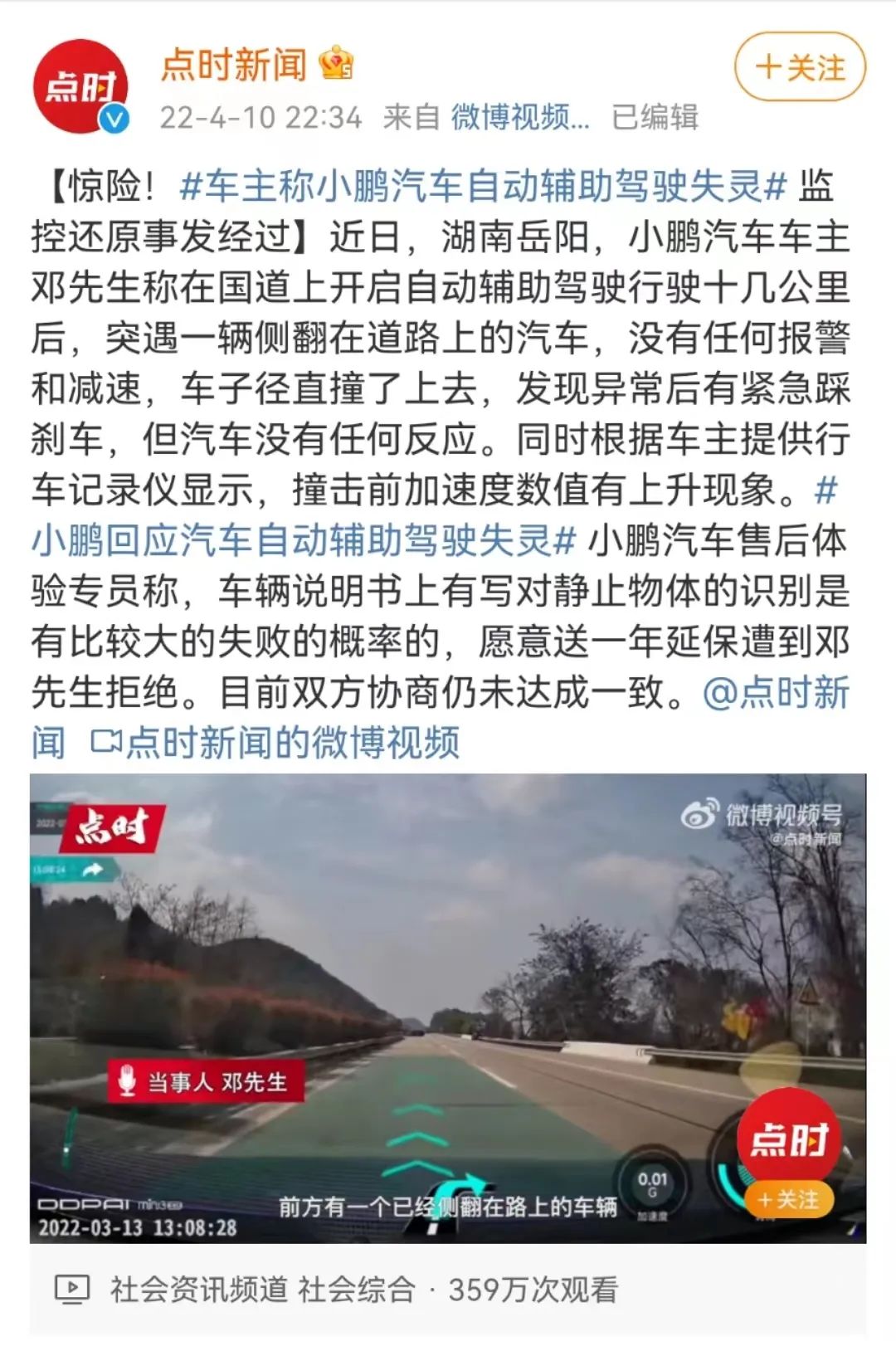
Ⅰ
Cases
Recently, in Yueyang, Hunan Province, Mr. Deng, the owner of Xiaopeng automobile, said that after driving more than ten kilometers on the national highway with automatic assistant driving, he ran into a car that overturned on the road. There was no alarm or deceleration. The car ran straight into it. After finding something abnormal, he stepped on the brake, but the car didn't respond. At the same time, according to the dash cam provided by the owner, the acceleration value before impact has increased. Xiaopeng automobile after-sales experience specialist said that the vehicle manual stated that there was a high probability of failure in the recognition of stationary objects, and Mr. Deng refused to extend the warranty for one year. At present, the two sides have not reached an agreement through consultation.

(picture from the network)
Ⅱ
Lawyer interpretation
Article 1202 of the civil code of the people's Republic of China stipulates that "if the defect of a product causes damage to others, the producer shall bear tort liability." Article 26 of the product quality law of the people's Republic of China stipulates that "producers shall be responsible for the quality of their products. The quality of products shall meet the following requirements: (1) there is no unreasonable danger endangering the safety of persons and property, and if there are national and industrial standards to protect human health and the safety of persons and property, such standards shall be met; (2) It has the service performance that the product should have, except that it explains the defects in the service performance of the product; (3) Conform to the product standard indicated on the product or its package, and conform to the quality status indicated by product description, physical samples, etc. "
According to the above legal provisions, consumers have the right to demand the producers to bear the liability for compensation in case of personal and property damage caused by product defects. Then, the focus of legal liability determination in this event is whether the product does have defects.
According to the classification of automobile driving automation issued by the State Administration of market supervision (Standardization Committee) for the automatic driving function, automatic driving is divided into six levels, from low to high: level 0 emergency assistance, level 1 partial driver assistance, level 2 combined driver assistance, level 3 conditional automatic driving Level 4 highly automated driving and level 5 fully automated driving. The Xiaopeng P7 model in this incident belongs to level 2 combined driving assistance level. According to the technical functions of this level, the driver is still the driving subject and cannot be separated from the driving operation. The driver needs to be responsible for supervising the driving automation system and intervening to take over when necessary.
As for this incident, the official response of Xiaopeng automobile said that the owner did not keep observing the environment in front of the vehicle and took over the vehicle in time, and said that "after investigation and determination by the local traffic police department, the conclusion is in line with the above situation". The after-sales experience specialist of Xiaopeng automobile said that it has always been difficult to identify stationary objects on the highway. Therefore, Xiaopeng automobile also indicated in the manual that "there is a high probability of failure in identifying stationary objects". But Mr. Deng, the owner of the car, said that he was not distracted when the accident occurred, and his hands did not leave the steering wheel. He also disclosed that after the event, he repeatedly negotiated with Xiaopeng automobile to ask for background driving data, but the other party refused to provide it.
To sum up, drivers at L2 level, that is, the combined driving assistance level, are still the main body of driving behavior. They should monitor the road environment and focus on driving tasks, and intervene in driving tasks when necessary to ensure vehicle safety. If Mr. Deng has fulfilled his duty of care and the traffic accident is caused by the failure of the operating system, Xiaopeng automobile should undoubtedly bear the corresponding liability for damages to Mr. Deng. On the contrary, if Mr. Deng violates the safety instructions and operation guidelines for assisted driving, resulting in a traffic accident, it can not be generally recognized as a product quality problem in judicial practice, and Xiaopeng automobile has no legal responsibility. However, it is worth noting that in the case of product liability, the vehicle manufacturer needs to bear the main burden of proof, that is, if Xiaopeng automobile can not prove that the vehicle has no technical defects, it still has to bear the adverse legal consequences.
Ⅲ
Knot
With the popularity of intelligent vehicles, the resulting traffic accidents and product quality disputes are also increasing. However, in the absence of a unified standard for technical defects, it is often difficult to identify whether there is a fault in the auto drive system. Therefore, it is recommended that owners fully understand the relevant safety instructions and operation guidelines when purchasing and using smart cars, and timely collect and fix relevant evidence in case of accidents, so as to protect their rights.


© Beijing JAVY Law Firm Beijing ICP Registration No. 18018264-1